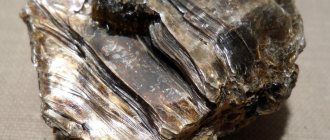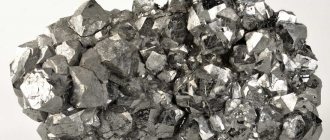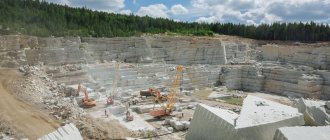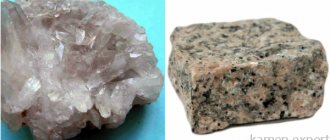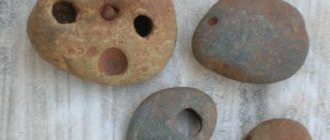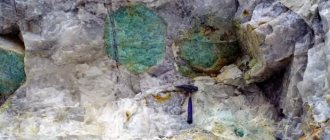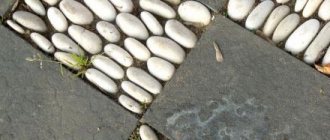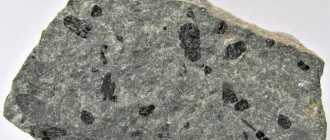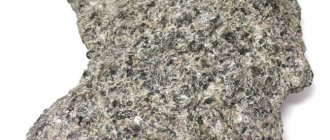The name granite comes from the Latin word granum, which means “grain”. This rock actually has a crystalline coarse-grained structure. The origin of granite can be igneous, metamorphic or mixed.
This rock has a crystalline coarse-grained structure
The igneous or volcanic origin of the granite massif is associated with the slow cooling and hardening of magma in the earth's crust. Metamorphically, minerals arise through the process of granitization, which is the sintering and partial melting of fragments of various rocks. But it is often very difficult for geologists to determine exactly how granite is formed, especially since this does not affect either the physical properties or the chemical composition. As a rule, huge granite layers lie beneath continents and form the basis for mountain ranges.
Physical properties and characteristics
The main physical properties of the material: strength, density, resistance to high temperatures and environmental influences.
If we compare this stone with concrete, the strength of the former will be much higher. For example, it can withstand pressure 6 times greater than concrete. The density of granite is another distinctive feature, because in relation to the same concrete it weighs 12% more.
The hardness of rocks primarily depends on the level of moisture absorption. The lower the percentage of moisture absorption in the stones, the stronger they are. In this regard, the mineral is the undisputed leader, since due to its depth of occurrence it absorbs moisture only within 0.2%. Secondly, the hardness of granite depends on the presence of quartz in it, which, among other things, also provides heat resistance. The melting point of the stone can reach 700°C. In addition, thanks to the same water resistance, it is able to withstand temperature changes within 100 degrees, so the number of freezing and heating cycles can reach hundreds of times.
The igneous or volcanic origin of the granite massif is associated with the slow cooling and hardening of magma in the earth's crust
In general, the physical properties and durability of this mineral also depend on its structure, according to which the following types of granite are distinguished:
- coarse-grained;
- medium grain;
- fine-grained.
The most valuable is the fine-grained structure less than 2 mm. This variety has better resistance to mechanical stress and a higher melting temperature.
Despite such high levels of strength and density, granite stones are a well-processed building material. They can be cut, sanded and polished without any problems. If minerals are carefully cut, they acquire a smooth and shiny surface, not inferior in beauty to marble.
Origin of granite
Among petrologists and geologists there is no clear opinion about the origin of granite. In the 18th and 19th centuries, it was believed that granites were formed by the deposition of crystals on the ocean floor, but the concept later gave way to the plutonic model, implying the formation of rocks at depths of more than 3 km at lithostatic pressures above 1 kbar.
Today it is obvious that the mineral has a heterogeneous nature, that is, it is formed in two ways: during the crystallization of the natural melt of magma during its transition to a solid state (cooling) and as a result of metamorphism - changes in igneous rocks under the influence of high temperature and pressure. Many experts argue that the formation of granite is completely impossible without the process of metamorphism.
Granites occur in the upper part of the earth's crust and are not present at the bottom of the oceans. The youngest minerals date back to 1-2 million years old, the oldest – 3.8 billion years. Initially, granite rocks did not come to the surface, but today the granites are exposed due to the uplift of roof rocks.
Chemical composition and varieties
If you examine granite in a cross-sectional diagram, you can clearly see inclusions of other minerals and the structure of the grains. Even a brief introduction to its structural features will help you understand what makes this stone unique.
The chemical composition includes mainly the mineral series, alkali and silicic acid. According to average indicators, the mineral composition of granite includes feldspars (plagioclase, orthoclase, potassium feldspar in the amount of 60-65%), quartz (up to 35%) and micas (muscovite, biotite - 5-10%). Iron, magnesium and calcium may be present in trace amounts.
The chemical component of this natural mineral also affects its color. Contrary to popular belief, a particular color of a stone is determined not by the presence of quartz in it, which, as a rule, is completely colorless, but by the feldspars and micas included in it. As for quartz, it mainly provides the stone with shine, although black-quartz specimens are found in nature.
The most common colors produced by feldspars are red, pink, orange and gray. Rarely found in nature are blue and green colors, or, as it is also called, amazonite. Mica gives the rock its dark color. One of the most common colors is pink granite, the shade of which can sometimes reach a light scarlet or even deep red color.
Properties of granite
- Durability. Granite is known as the "eternal" stone. Indeed, fine-grained rocks show the first signs of wear and destruction only after 500 years. The granite sarcophagus in the Great Pyramid of Giza (built approximately 4,500 years ago) has remained virtually unchanged over time.
- High strength. This characteristic also depends on the grain size. Rocks with a fine-grained structure have a compressive strength of about 300 MPa. In this parameter, granite is significantly superior to other materials. For example, the compressive strength of concrete of the highest class B30 is only 39.29 MPa, and clinker brick M1000 is 100 MPa. In simple terms, the stone can withstand pressure of about 2200 kg per cm². The tensile strength is low and is only 3% of the compressive strength. If mining technology is violated, thin cracks can form in the stone, which have virtually no effect on the compressive strength, but reduce the tensile strength.
- High resistance to acids and natural phenomena in general. Stone can withstand about 300 freeze-thaw cycles, which makes it one of the best materials for exterior decoration.
- Average fire resistance. As a result of polymorphic transformations of quartz, granite cracks at temperatures above 600°C. The stone cannot withstand direct contact with fire, but it is still suitable for arranging fireplaces (as well as marble), since the temperature of their external cladding rarely exceeds 120°C. The melting point of granite is on average 1200°C, but in the presence of water this parameter is significantly lower - about 650°C.
- Waterproof. The water absorption coefficient of the mineral is 0.05–0.17%, which is comparable to marble. This stone practically does not absorb moisture, which makes it ideal for the construction of fountains, embankments, and swimming pools. This parameter indirectly affects frost resistance. Low water absorption is a consequence of the low porosity of the material. In granites, pores occupy no more than 1.5% of the total volume.
The environmental friendliness of granite is a stumbling block among both suppliers and buyers. As a rule, this mineral is not hazardous to human health. The radiation level of most types of granite does not exceed 0.05 μSv/hour, while up to 0.25 μSv/hour falls per person every hour - this is the average value consisting of cosmic background, terrestrial radiation and incorporated radiation (received from water and food) .
Yes, some types of granite are used for uranium mining, but such stone is not used in construction. Myths about the strong radiation background of the mineral are just that: myths that have nothing to do with reality. Rocks with truly dangerous background radiation account for no more than 2-3% of the total mined volume. You can read more about the radioactivity of natural granite here.
Types according to chemical composition
The composition of granite not only affects the color of the rock or structure, but also determines its variety. Depending on the content of dark-colored elements in it - micas - geologists distinguish the following varieties of the mineral:
- Aleksit does not contain dark-colored inclusions at all.
- Leucogranite - low mica content.
- Alkaline - granite, which contains alkaline amphiboles.
- Biotite - 6-8% biotite.
- Double mica - includes 2 elements: muscovite, biotite.
- Lithium fluoride - contains exclusively lithium elements.
Granite mining
Granite mining is fundamentally different from the methods of mining other minerals. As in the case of marble, it is important to maintain the integrity of the blocks and prevent the formation of cracks, which significantly reduce the strength characteristics of the material. There are three main methods of quarrying stone:
- Drilling and blasting. Cheap, homemade and, in fact, “barbaric” method. As a result of explosions, blocks with high fracturing and a large (often up to 30%) amount of waste are formed. Shafts are drilled into the rock mass into which industrial explosives are placed. One explosion requires from 10 to 30 wells and several tons of explosives. It is almost impossible to predict the behavior of a rock mass during blasting. After the explosion, the resulting blocks are sorted and sent for cutting.
- Air cushion chipping. The excavation area is outlined by drilled holes into which air is pumped under high pressure. As a result, the stone blocks are separated from the massif, and in this case the fault area can be accurately predicted. The technique does not lead to destruction and crumbling of the rock, and does not cause cracks in the blocks. As a result, the resource of the field is spent more rationally.
- Stone-cutting. To separate blocks, special equipment with diamond cutters is used. As a result, massive (40-60 tons) blocks of regular shape are mined, which are removed from the mining area by heavy cranes. The method has become widespread in Europe.
There are alternative methods for extracting granite: burocline, when holes are drilled into the stone and liquid is pumped into them, and the “silent explosion” method, which involves pumping a non-explosive expanding mixture into the holes.
Granite: is it a mineral or rock
Granite is a mountainous mineral rock with a complex composition. This is what geologists, mineralogists, and geographers will say.
For them, it is a mineral; for everyone else, it is a stone, symbolizing durability, strength, and steadfastness.
To say that a mineral has a rich history is not enough. He himself is history: so many ancient and modern monuments of world culture were created from him.
And the famous phrase “gnawing the granite of science” means stubbornly overcoming solid knowledge that has been accumulated by people’s experience.
Interesting facts about granite concern everything connected with it: the origin of its crystals in nature, qualities, types of granite. This will be discussed further.
Use of granite
- Construction. The heaviness and high cost of stone do not allow its use in mass construction, but it is still used for the construction of individual residential and public buildings.
- Facing works. Granite is used to decorate building facades and premises, floor coverings, stairs and columns. The high frost resistance of the stone allows it to be used for decorative exterior decoration. The mineral is widely used to create paving stones, finish sidewalks, and produce borders.
- Production of interior parts. Polished granite is suitable for creating countertops, window sills, bathtubs and sinks. Small architectural compositions are made from it.
- Filling roads, concrete production . Waste stone resulting from drilling and blasting is used as crushed stone for laying roads and making concrete structures.
- Production. The rock, which has a high potassium feldspar content, is used as a flux in the manufacture of glass and fine ceramics.
- Making paving stones. Due to its strength and durability, granite paving stones have been popular for many centuries. Read more about granite paving stones.
Along with marble, granite is one of the most popular natural materials in the construction and finishing industries. It makes magnificent bas-reliefs, monuments, pilasters and other decorative elements. Due to its low abrasion rate, this mineral is ideal for arranging floors in high-traffic areas.
Granite buildings have retained their original appearance for centuries. A worthy example is the majestic building of the Renaissance, the eighth wonder of the world - the Spanish monastery of El Escorial. More than a million tons of gray granite were used for its construction.
St. Petersburg residents don’t have to look far for an example. Walking through the historical center of the city, you can pay attention to the dominant role of granite in architectural ensembles. Numerous embankments, the facade and interior decoration of the majestic St. Isaac's Cathedral, the famous Atlas, the decoration of metro stations, granite columns inside the Kazan Cathedral. Egyptian sphinxes near the Academy of Arts, the legendary “thunder stone” in the pedestal of the Bronze Horseman. The symbol of the city, the Pillar of Alexandria, which weighs up to 600 tons, was hand-carved from a single piece of Vyborg granite. Interestingly, the pillar is not secured by anything; it stands thanks to its own weight and perfectly calculated design.
Granite in the interior
Granite rocks are widely used in all types of interior decoration.
- decorative granite cladding: walls, floors, stairs and fireplaces. The stone is suitable for any room. It is resistant to the moisture of a bathroom or swimming pool, to most household contaminants in the kitchen, and it practically does not wear out in conditions of high traffic. Therefore, when finishing floors and stairs in public institutions (metro stations, railway stations, shopping centers), craftsmen give preference to granites.
- creation of functional products: countertops, window sills and stone furniture.
- production of decorative elements: sculptural compositions, flowerpots, mosaics and panels.
How is the density of granite determined?
The average density of granite is the weight of the material per unit volume. The indicator is expressed in g/cm3 or kg/m3.
To determine the density of granite, prepare 5 samples of regular cubic shape. The stone is dried and immersed in water at a temperature of +4 °C. Knowing the weight of the displaced liquid, the mass and volume of the sample determine the density of the mineral. For rocks from different deposits, the indicators will be different.
Granite density table, kg/m3
| Granite type | Average density |
| Kurtinsky | 2640 |
| Kapustinsky | 2850 |
| Pokostovsky | 2640 |
| Vasilievsky | 2680-2685 |
| Leznikovsky | 2650 |
| Korninsky | 2650 |
| Mezhirichensky | 2600 |
History of granite stone
Granite photo of stone
One modern lyricist in verse describing granite talks about its name. The author finds consonance with the word “edge”, associating the mineral either with the edges of gravestones or with the boundaries of existence. But in fact, the etymology of the term has Latin roots.
The very first person to use the definition was the Italian naturalist Caesalpinus. It was he who created the word derived from the Latin “granum” - “grain”, and used it in the scientific context of his work “De metallicis” (1596).
But, of course, the stone itself was used a long time ago in the construction of fundamental buildings of ancient empires - Egypt, Rome, India.
The importance of the mineral is that it plays a significant role in the composition of the earth's crust. There are even entire granite mountains, for example, the famous Mont Blanc. Maybe that’s why reliability is associated with the strength of granite.
It is noteworthy that its crystals are not found on other celestial bodies. For comparison: basalt is found in the surface structure of the Moon and terrestrial planets. That is why geologists wrote a saying about stone: “granite is the calling card of the Earth.”
Where is granite mined?
Deposits of granite rock have a global scope. In Russia alone there are 50 mining sites from which stones of different types and varieties are exported. Mostly, these are gray granite and varieties of white and brown. Decorative stones - pink and red granite - are found on the Kola Peninsula, Karelian deposits and in the Leningrad region.
The deposits of Ukraine are noteworthy, especially the Crystal Shield deposit, 200 km wide. It stretches from northwest to southeast for 1000 km across the country. Krivoy Rog quarries provide the world with rare black granite, and the Zhitomir region is rich in high-quality facing stone.
European deposits also contribute to the extraction of beautiful varieties of the mineral. Italy, and more specifically Sardinia, is rich in light pink and soft gray rocks. Other popular and less valuable species contain Bulgarian, Portuguese, Spanish, and Finnish deposits. The mineral is also mined in Germany and the UK.
However, the leader in production of the breed is Somalia, followed by Ethiopia and other countries of the African continent. Taken together, their figures amount to at least 120,000 m³ per year. So-called porphyry stones, red-colored minerals, as well as light gray types are mined there. Namibia is rich in deposits of dark blue samples, which are classified as rare minerals.

